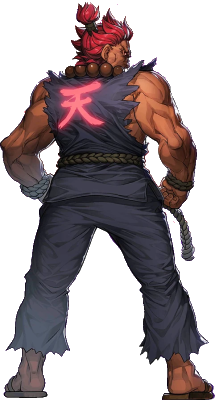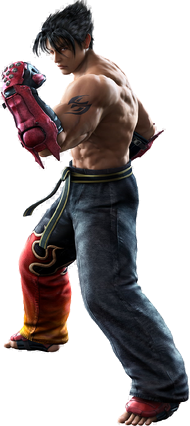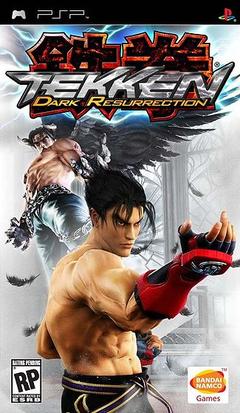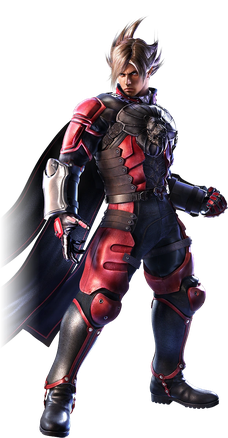Tekken is a Japanese media franchise centered on a series of fighting games developed and published by Bandai Namco Entertainment. The franchise also includes film and print adaptations.

Akuma, known in Japan as Gouki, is a fictional character from the Street Fighter series of fighting games created by Capcom. Akuma made his debut in Super Street Fighter II Turbo as a secret character and an alternative boss to the villain M. Bison. In the storyline, he is the younger brother of Gouken, Ryu's and Ken's master. After defeating his brother, Akuma gains interest in several fighters, most notably Ryu as he senses that the protagonist has a similar power to him known as the Satsui no Hadou. In some games, he also has an alternate version named Shin Akuma or Shin Gouki in Japanese and Oni Akuma in Super Street Fighter IV: Arcade Edition.

Ken Masters is a character in Capcom's Street Fighter fighting game series. The character was first introduced in the 1987 title Street Fighter as an alternate fighter to Ryu. While Ken and Ryu are devoted to testing their power against many different fighters as older more experienced fighters in Street Fighter II, Ken instead ends his story developing a family with his girlfriend Elisa. Ken still keeps appearing in the following games, including the Street Fighter Alpha younger fighter or the spin-off Street Fighter EX. An alternate brainwashed version of Ken has also appeared as a boss character in a few of his appearances. The character has been featured in several sequels to Street Fighter as well as adaptations based on the games. He has also made cross-over appearances in Namco × Capcom, Project X Zone and Super Smash Bros.

Tekken 4 (鉄拳4) is a 2001 fighting game developed and published by Namco for arcades. It was developed for Namco's System 246 hardware and then ported to the PlayStation 2 home console in 2002. It is the fourth main installment in the Tekken series as the sequel to Tekken 3 (1997), and the fifth overall following the non-canon title Tekken Tag Tournament (1999). The game harbored many gameplay revisions, such as the series-unique ability for the player to move about before the round begins and the introduction of walled stages.

Tekken 3 (鉄拳3) is a 1997 fighting video game developed and published by Namco. It is the third installment in the Tekken series and the first game built on the Namco System 12 arcade hardware. Plotwise, the game takes place twenty years after Tekken 2 (1995) and features a largely new cast of characters, including the debut of several now-staple characters such as Jin Kazama, Ling Xiaoyu and Bryan Fury, and adds sidestepping ability to every character in-game. Tekken 3 was ported to the PlayStation in 1998 with additional content, including a beat 'em up mode called Tekken Force.

Tekken 5 (鉄拳5) is a 2004 fighting game developed and published by Namco for arcades, before being ported to the PlayStation 2 in 2005. It is the fifth main game in the Tekken series, marking the tenth anniversary of the series. The game is set shortly after the events of Tekken 4 featuring a new Antagonist named Jinpachi Mishima taking over the Mishima Zaibatsu while a sidestory focuses on the protagonist Jin Kazama as he faces several enemies from the G Corporation. The home version also contains a collector's edition of sorts, as it includes the arcade versions of Tekken, Tekken 2, Tekken 3, and StarBlade.

The main titles of the Street Fighter fighting game series have introduced a varied cast of 87 characters from the main series, and 34 from several spin-offs, for a total of 121 playable characters who originate from 24 countries, each with his or her unique fighting style. This is a list of playable characters and non-playable opponents from the whole franchise. They are categorized based on the game in which they first became playable, including the original Street Fighter game, the Street Fighter II series, the Street Fighter Alpha series, the Street Fighter III series, the Street Fighter IV series, Street Fighter V, Street Fighter 6 and other related games.

Eddy Gordo is a fictional character from the Tekken series by Bandai Namco Entertainment. Eddy is a Brazilian capoeira fighter. Introduced in the 1997 fighting game Tekken 3, Eddy has since appeared in every main game thereafter.

Jin Kazama is a fictional character and the protagonist of Bandai Namco's Tekken series. Introduced in the 1997 game Tekken 3, he has been the central character of the series from that game onwards. Trained by his grandfather Heihachi Mishima, Jin wishes to avenge the apparent death of his mother, Jun Kazama, at the hands of Ogre. However, Heihachi betrays Jin to awaken a genetic abnormality within the latter's body known as the Devil Gene, leading Jin to seek revenge against his grandfather in later installments.

Heihachi Mishima is a fictional character and one of the main antagonists of Bandai Namco's Tekken series. Introduced as a boss character in the first Tekken game from 1994, Heihachi is depicted as the abusive father of Kazuya Mishima and the CEO of a military firm known as the Mishima Zaibatsu, which was founded by his father, Jinpachi Mishima. Heihachi has served as the protagonist of Tekken 2 and Tekken 7, as well as a boss character in several other installments of the series. As one of the main characters, he is one of the four characters to be playable in all eight main instalments.

Kazuya Mishima is a fictional character and one of the main antagonists of Bandai Namco's Tekken series. Debuting as the protagonist of the original game, Kazuya has since become one of the series' most prominent villains after serving as the penultimate boss of Tekken 2. The son of a wealthy zaibatsu CEO named Heihachi Mishima, Kazuya seeks revenge against his father for throwing him off a cliff years earlier. Kazuya becomes corrupted in later games, seeking to obtain more power and eventually coming into conflict with his own son, Jin Kazama. Kazuya Mishima possesses the Devil Gene, a demonic mutation, which he inherited from his late mother, Kazumi Mishima, which can transform him into a demonic version of himself known as Devil Kazuya. Devil Kazuya has often appeared as a separate character in older installments prior to becoming part of Kazuya's moveset in Tekken Tag Tournament 2 and later games. Kazuya Mishima is also present in related series media and other games.

Tekken 6 is a 2007 fighting game developed and published by Bandai Namco Games. It is the sixth main and seventh overall installment in the Tekken franchise. It was released on arcades in November 2007 as the first game running on the PlayStation 3-based System 357 arcade board. A year later, the game received an update, subtitled Bloodline Rebellion; both versions also saw a limited release in North America. A home version based on the update was released for the PlayStation 3 and Xbox 360 in October 2009; this was the first time a main installment was produced for a non-Sony console. A port to the PlayStation Portable was also released shortly after.

King is a title used by two characters in the Tekken fighting game series created by Bandai Namco Entertainment. The characters were inspired by Japanese pro wrestler Satoru Sayama, as well as Mexican wrestler Fray Tormenta, a Catholic priest who became a luchador in order to support an orphanage. The identity of King has been present in all the main Tekken installments to date, with King I part of the roster in Tekken and Tekken 2, and King II debuting in Tekken 3 and returning for the following main games since.

Tekken 5: Dark Resurrection is a 2005 fighting game and a standalone update to the PlayStation 2 game Tekken 5. The arcade version was released in Japan in December 2005 and later worldwide in February of 2006, while the PSP version was released later that year in July 2006. The game was also released as a downloadable game on the PlayStation 3 via the PlayStation Network online service in Japan in 2006 and the rest of the world in 2007. A sequel, Tekken 6 was released in 2007.

Tekken (鉄拳) is a 1994 fighting game developed and published by Namco. It was originally released on arcades, then ported to the PlayStation home console in 1995. One of the earliest 3D polygon-based games of the genre, Tekken was Namco's answer to Virtua Fighter and was designed by Seiichi Ishii, who himself was also Virtua Fighter's designer when he worked at Sega previously. The game was developed on the purpose-built low-cost System 11 board, based on PlayStation hardware.

Bandai Namco Entertainment'sTekken media franchise is known for its diverse cast of characters hailing from various nationalities, all coming together to compete in the King of Iron Fist tournament. In addition to the human characters, Tekken also features non-human characters for comic relief, such as the bear Kuma, his love interest Panda, the boxing kangaroo Roger, and the dinosaur Alex. Certain characters like Jin Kazama, Kazuya Mishima, Lee Chaolan, and Jun Kazama have their own alternative versions. Each character has their own goals for participating in the tournament.

Rufus is a character in Capcom's Street Fighter series of fighting games. Designed by Daigo Ikeno for Capcom's development team, he first appeared in the arcade version of Street Fighter IV and later in related promotions and media for the title.

Lars Alexandersson is a character from the Tekken fighting game franchise by Bandai Namco Entertainment. First introduced in the 2008 arcade game update Tekken 6: Bloodline Rebellion, he serves as the main protagonist of the Tekken 6 story mode.

Tekken X Street Fighter was a planned crossover fighting game that was being developed by Bandai Namco Entertainment. It was supposed to cross the universes of Namco's Tekken and Capcom's Street Fighter into one game, creating a roster from both franchises. The game was announced at the 2010 San Diego Comic-Con by Bandai Namco producer Katsuhiro Harada. The gameplay of Tekken X Street Fighter was going to feature the same 3D fighting game engine of the Tekken franchise, as opposed to Street Fighter X Tekken, which features the 2D-style gameplay of Street Fighter IV. Bandai Namco put the game's development on hold in 2016.

Tekken Tag Tournament 2 is a 2011 fighting game, the eighth installment in the Tekken fighting game series and the sequel to Tekken Tag Tournament. It was released for the arcades in September 2011. It received an update, subtitled Unlimited, in March 2012. A console version based on the update was released for PlayStation 3 and Xbox 360 in September 2012, prior to the update. It was ported to the Wii U as one of the system's launch titles in November 2012, subtitled Wii U Edition.



















